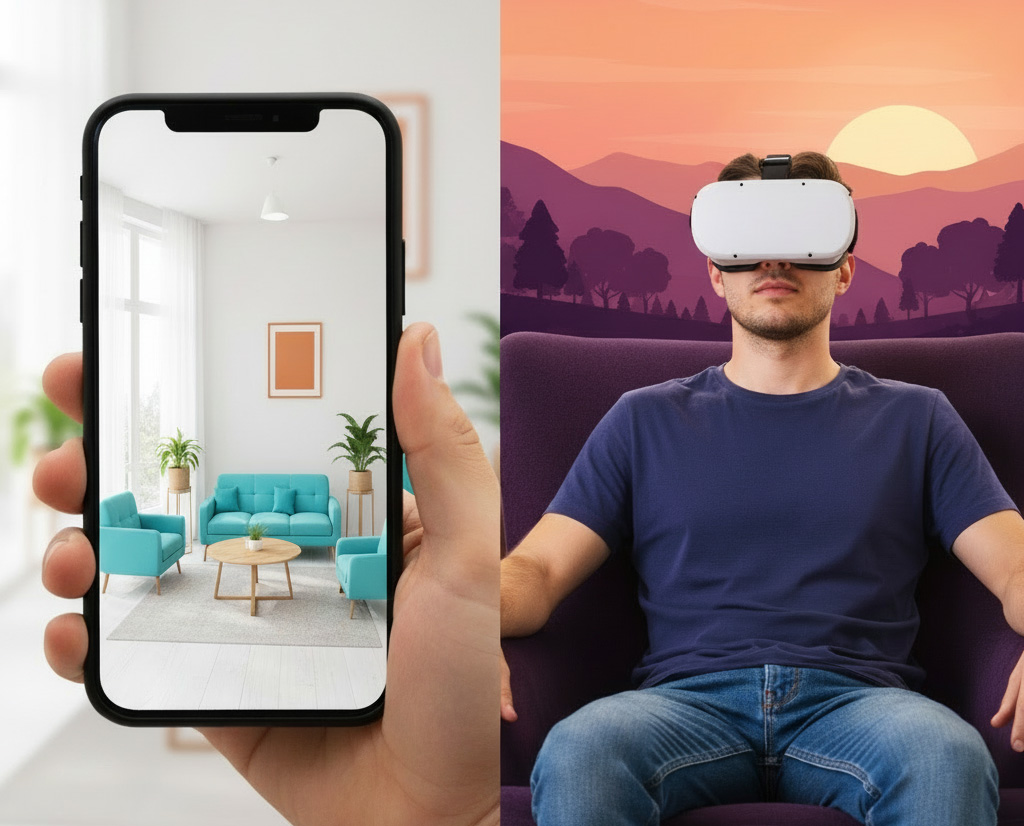

A clear look at how AR and VR relate, how they share the same sensing and tracking foundation, and why they sit on one continuous immersive spectrum.

Augmented reality overlays digital content into the real world. Virtual reality replaces the real world with an entirely digital one. These combine into a single continuum with common immersive technologies, hardware and interactions.
AR and VR sit on two ends of a shared spectrum. VR separates you from the real environment and places you in an entirely digital space. AR maintains your view of the environment and adds layers of digital information, objects and guidance on top of what you already see. Similar technologies like sensing, mapping and motion understanding allow these technologies to feel immersed in a transformed environment.
VR headsets like the Meta Quest rely on inside-out cameras, 6DoF tracking and motion sensors to understand your exact position and orientation in space. This allows the device to simulate a full-scale digital environment around you. AR headsets and mobile devices use cameras, LiDAR, and technologies like ARKit, ARCore, plane detection, and world tracking to understand the physical geometry in your space, so digital content can be appended to your surroundings.
These systems share a common foundation. They both depend on spatial awareness, movement tracking, and real-time rendering of graphics. The difference is how each one of them uses that foundation. VR builds entirely new worlds around you. AR modifies the world you are standing in already. Why do both technologies feel related even though they seem to imply different futures? The reason is that they’re built from the same sensing and tracking technology while achieving different goals.
Having a strong understanding of how AR and VR fit together clarifies when to use each medium. Virtual reality is strongest when you need full immersion. This can be perfect for training simulations, situational immersion and gaming which require removing distractions and giving users absolute focus. AR is strongest when digital content is meant to support a real-world task or extend your environment. This is perfect for contextual instructions, showcases, and location-based information in your space.
These differences shape how people interact with immersive content. VR can feel powerful for deep work and expansive experiences. AR gives you timely contextual information without removing you from your surroundings.
Over time, AR and VR will not feel like separate categories. They will act as adjustable levels of immersion. Devices like the Meta Quest 3 and Apple Vision Pro already do this, and you can move between a VR environment and an augmented reality one. A training experience may start in VR for safety, then move to AR for on-site guidance. A shopping experience may begin with AR labels on a physical product and then shift into VR for a full immersive preview.
Spatial designers get to choose where their experience will sit along the spectrum. VR prioritizes immersion and more static experiences, whereas AR prioritizes extending your space and moving from location to location. Both require attention to usability, spatial awareness, and clarity. When creating AR interfaces, designers need to consider legibility against various backgrounds. The physical environment shapes your layout and canvas. VR interfaces can use larger scale interfaces, but must avoid sensory overload.
• An AR overlay on a car can show instructions about operating buttons and controls.
• A VR experience in a digital car can simulate driving through the Swiss Alps.
• A blended AR/VR experience could overlay graphics on the interior of a car and show the streets of Tokyo through the windows on the outside.
• An architecture firm can use Trace to show immersive CAD plans in a warehouse and seamlessly transition from the AR view to an immersive VR experience on the Apple Vision Pro.
• AR and VR are not opposite technologies. They solve different problems on a continuous spectrum.
• AR is not just simple overlays. It can anchor digital content all around you in space.
• VR is not limited to gaming. It can also support training, simulation, design, and research.
Spatial computing, 6DoF, ARKit, World mesh, VR controller, Depth sensing
AR and VR share a common foundation, but they each serve a different purpose based on how much a user wants to be immersed. When considered as two ends of one spectrum, the strengths of each become clear, and new possibilities appear in the space between them.
Learn about augmtened reality or start creating your own experiences.